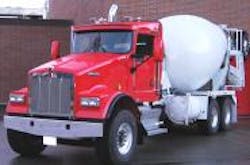Truck makers relying on selective catalytic reduction (SCR) technology to get their vehicles into compliance with 2010 emission rules are finding out that diesel exhaust fluid or “DEF” is probably one of the most critical pieces of the SCR system that needs explaining.
That’s because it’s not all about helping customers and dealers actually locate supplies of DEF in the marketplace; it’s also about how DEF affects base vehicle spec’ing choices as well.
Judy McTigue, director of marketing and planning research for Kenworth Truck Co., recently discussed this during a speech at Integer Research’s recent Diesel Emissions Conference I attended in San Diego.
She revealed that Kenworth actually started working on its 2010 solution way back in August 2006 – almost a full year before the 2007 emission regulations were put in place – and began educating its dealer network about SCR in early 2008, followed by a variety of customer outreach efforts in 2009.
“We knew we couldn’t wait until six months before the implementation of the 2010 emission standards to start communicating with our dealers and customers,” she explained. “With customers, not only did we begin the ‘education’ process about SCR a full year before the2010 regulations went into effect, we used a variety of methods as well – town hall meetings, webinars, and one-on-one customer visits. Those one-on-one visits really proved to be of the most benefit.”
Much of the discussion, though, didn’t revolve around SCR so much as DEF; the ammonia-based liquid that is 67.5% water sprayed into the exhaust stream of a diesel-powered truck to reduce oxides of nitrogen (NOx) emissions down to the required level of 0.2 grams per brake horsepower hour (g/hp-hr) as mandated by the 2010 emission rules.
Locating DEF on a regular basis initially posed a challenge, said McTigue, but that’s been worked out fairly quickly and isn’t much of an issue anymore, as she notes in the video clip below:
Another issue, however, posed a trickier set of challenges: just how much DEF would a fleet need to keep on board their vehicle?
McTigue said Kenworth worked this out by offering a range of storage tank options based on customer duty cycles: four to be exact. For long-haul fleets, they can spec a 27 gallon DEF tank that should last for 5,400 miles of operation. Then there’s an 18 gallon DEF option, which provides 3,600 miles of range, followed by a 9 gallon size for 1,800 miles or range and, lastly, a 5.6 gallon DEF tank for about 1,100 miles of range
Each of those options gives customers more refilling flexibility depending on the duty cycle of their vehicles, matches the available “real estate” on the chassis, and of course helps reduce weight if that’s a major issue. Overall, McTigue said Kenworth has found its SCR system can add between 250 to 300 extra pounds to a truck, so having tank size flexibility is a critical option.
Then of course there’s the “alerts and consequences” part of SCR, where running out of DEF triggers a slowdown in vehicle option, per rules outlined by the Environmental Protection Agency (EPA). McTigue went into that during her speech as well, as you can see below:
The most important thing, though, about SCR in Kenworth’s eyes is that it finally is allowing the OEM to recapture engine efficiencies lost during the first two rounds of emission regulations (2004 and 2007) due to the need to reduce particulate matter (PM) or “soot” emitted from diesel engines.
McTigue said 2007-compliant engines equipped with exhaust gas recirculation (EGR) systems to reduce soot suffered a fuel economy penalty of 5% to 9%. Now, with SCR, engines are showing a 5% gain in fuel economy over the ’07 models – recapturing some of what was lost in EGR-only engines.
She added that heat rejection in 2010-model SCR engines has also dropped, compared to the 20% to 30% increase seen in ’07 engines, with new 2010 engines also gaining back some of the 50 to 100 horsepower lost in the ’07 engines due to the impact of EGR.
Yet all of the SCR technology required to meet the 2010 rules comes with stiff price tag; an average of $7,000 to $10,000, depending on the size of the engine and type of truck it powers, according to Kenworth’s numbers – following, of course, the $6,000 to $8,000 price increase attached to the ’07 model engines.
Still, due to the fuel economy gains McTigue said SCR is producing, some of that can be earned back over time.
Right now, Kenworth’s medium-duty trucks equipped with SCR are garnering a net gain in fuel economy of 3% – an overall 5% improvement in fuel efficiency less 2% to cover the amount of DEF consumed. That translates into a fuel savings of some $450 per year versus an EGR-only truck. For heavy-duty models, that fuel savings climbs to $1,750 per year
Of course, it would be even better if there were no cost premiums to account for when it comes to paying for SCR engines, but that’s life in the world of trucking in the "post-emission-regulation" age.
Now it’s just to wait and see what other mandates – particularly in the realm of fuel economy standards – might now get added to trucking’s plate.
